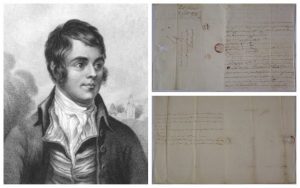Today our poetry news round up is dedicate to Robert Burns on the 259th anniversary of the poets birth.
25th January – Burns Night
 Today all across Scotland, and wherever else they may be in the world the Scots are getting ready to celebrate Burns Night.
Today all across Scotland, and wherever else they may be in the world the Scots are getting ready to celebrate Burns Night.
Possibly the most famous, and recognised Scottish poet worldwide Robert Burns, who is also referred to as

was born on 25th January 1759. Burns Day is celebrated every year on his birthday.
Although Burns only lived until the age of 37 he was not only a poet but also an outspoken political commentator. He was one of the pioneers of the Romantic movement, and a huge inspiration for the founders of both the liberalism and socialism movements.
Traditionally the evening is celebrated with traditional Scottish fare, which will almost certainly include Haggis, and drink – this is usually referred to as a Burns supper, and the first one was held in 1801. Whilst many new rituals have been added to what might constitute a traditional burns night since 1801 the main part of the celebration still revolves around the Haggis itself and the host will begin the evening by reciting “Address to a Haggis” one of Burn’s most famous poems
There is a good chance that during a Burns evening celebration “Auld Lang Syne” may also be heard; another poem by Burns.
3D Animation to be screened on Burns Day
Today, members of the public visiting the Scottish National Portrait Gallery in Edinburgh will be able to see “To A Mouse” by Robert Burns brought to life thanks to a new 3D animation. Thanks to the latest technology, and using a partial cast of the bard’s face which was taken of his skull 40 years after his death, a 3D version of Burn’s face has been created.
A team made up of faculty members from Liverpool John Moores University and the University of Dundee worked together on the project which was the idea of Rab Wilson, an Ayrshire poet. Wilson has lent his voice to the animation project to complete it; motion capture was used to capture his facial movements during the recitation and add them to the animation.
Newly Identified Letters Shed Light on Robert Burns
Two letters written in 1789 and 1796, that give a fresh idea of the extent of the radical politics of Robert Burns have recently gone on display.
The letters, which were composed by John Mitchell, who was the boss of

one of the most important people to the poet, show a lot about what his contemporaries thought of Burns.
The first makes mention of Burns attitude on being told he had been given a job as an exciseman, whilst the second talks of making provision for the poets family following his death.
The letters which make interesting reading will be on display from 25th January to 23rd February as part of the

exhibition at the Edinburgh’s General Register House.


You must register to comment. Log in or Register.